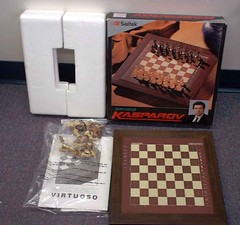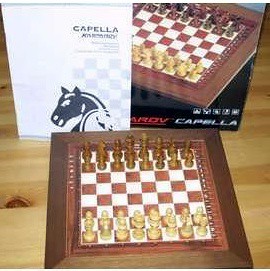
There are some minor differences between the Corona and Stratos boards in addition to the auto sensory/Pressure sensory difference
an amusing one is the manner in which the Stratos indicates Nodes per second
the Corona shows the node count in the normal numerical display of xxxx
while the Stratos does so in Exponential notation
so for example a node count of 2000 appears in the display as 10^3 ... 2
or 50000 as 10^4....5
the only computer i can think of that displays nodes this way
having lost the last game to the greatly lower rated Corona i gave the Citrine the white pieces for this game against the Stratos
in the game thankfully the Citrine was not out booked and left book at move 12
[White "Novag Citrine"]
[Black "Saitek Stratos"]
[Time Control "Game 30Min"]
1.e4 e5 2.Nf3 Nc6 3.Bb5 a6 4.Ba4 Nf6 5.O-O Be7 6.Re1 b5 7.Bb3 O-O 8.c3
d6 9.h3 Bb7 10.d4 Re8 11.Nbd2 Bf8

the Citrine is now out of book with a reasonable PV of +.16 .Stratos views the position as -.01
12.a4 Qd7 13.Ng5 d5 14.exd5 Na5
15.dxe5 Nxb3 16.Qxb3 h6 17.Ngf3 Nxd5 18.axb5 axb5 19.Rxa8 Rxa8 20.c4 Nb4
21.e6 fxe6 22.cxb5 Bd5 23.Qc3 Bd6 24.Nd4 Na2 25.Qe3 e5 26.Nc6 Bxc6
27.bxc6 Qxc6 28.Ne4 Nxc1 29.Rxc1 Qb5 30.Qd2 Kh8 31.b3 Qb6 32.Qc2 Qb4
33.Rd1 Ra3 34.Qc4 Qxb3 35.Qxb3 Rxb3 36.Nxd6 cxd6 37.Rxd6 Rb1+ 38.Kh2 Rb2
39.Kg3 Rb3+ 40.Kg4 Rb2 41.Kf3 Rb3+ 42.Ke4 Rb2 43.Ke3 Rb3+
44.Rd3
[fen]7k/6p1/7p/4p3/8/1r1RK2P/5PP1/8 w - - 0 44[/fen]
the game is drawn ..interestingly the Stratos sets in for a long 2 minute think here possibly considering what an exchange of rooks would bring in ..
its PV shows +.63 but it elects to not exchange ...
44..Rb2 45.Rd7 Rb3+ 46.Ke4 Rb2 47.Kf3 Rb3+ 48.Ke2 Rb2+ 49.Ke1 Kh7 50.Re7 Rb5
51.Kd2 Kg6 52.Ra7 Rb1 53.Ke3 1/2-1/2
FINAL POSITION
[fen]8/R5p1/6kp/4p3/8/4K2P/5PP1/1r6 w - - 0 53[/fen]
DRAWN
both computers were showing PV's of less then .3
so i called it a day
as both the Stratos and Corona are far weaker in Elo then the Citrine the score of .5-1.5 is nothing for the Citrine to be proud of
the next and final game against the Saitek mid-sized wooden boards features the President
a much stronger opponent then either the Stratos and Corona and with the Citrine having the Black Pieces...
this could get...
Ugly Regards
Steve






